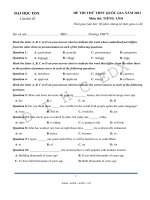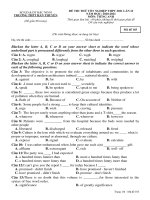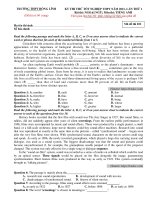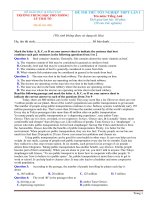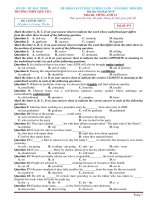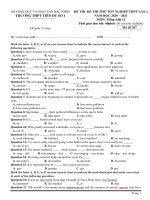Đề thi thử tốt nghiệp THPT năm 2021 môn Tiếng Anh có đáp án - Trường THPT Lý Thái Tổ (Lần 1)
Bạn đang xem bản rút gọn của tài liệu. Xem và tải ngay bản đầy đủ của tài liệu tại đây (249.36 KB, 5 trang )
SỞ GIÁO DỤC & ĐÀO TẠO
TRƯỜNG TRUNG HỌC PHỔ THÔNG
LÝ THÁI TỔ
Mã đề thi: 896
ĐỀ THI THỬ TỐT NGHIỆP THPT LẦN 1
Tên môn: Tiếng Anh
Thời gian làm bài: 60 phút;
(50 câu trắc nghiệm)
(Thí sinh khơng được sử dụng tài liệu)
Họ, tên thí sinh:..................................................................... Số báo danh: .............................
Mark the letter A, B, C, or D on your answer sheet to indicate the sentence that best
combines each pair sentences in the following questions from 1 to 2
Question 1: Beef contains vitamins. Generally, fish contains almost the same vitamins as beef.
A. The vitamins content of fish may be considered in general as similar to beef.
B. Generally, beef and fish may be considered to be a combination of vitamin content.
C. The vitamins content of beef is generally considered to come from fish.
D. What vitamin fish contains may be considered in general to be made from beef.
Question 2: The man was shot in the bank robbery. The doctors are operating on him.
A. The man whom the doctors are operating on him shot in the bank robbery.
B. The doctors are operating on the man who was shot in the bank robbery.
C. The man was shot in the bank robbery where the doctors are operating on him.
D. The man was whom the doctors are operating on him shot in the bank robbery.
Read the following passage and mark the letter A, B, C, or D on your answer sheet to
indicate the correct answer to each of the questions from 3 to 9
Today, there are 600 million cars in the world. They may seem like a lot. However, there are over
7 million people on our planet. Most of the world’s population uses public transportation to get around.
The number of people using public transportation continues to rise. Subway systems worldwide carry 155
million passengers each day. That’s more than 30 times the number carried by all the world’s airplanes.
Every day in Tokyo passengers take more than 40 million rides on public transportation.
Yet many people see public transportation as ‘a depressing experience’, says author Taras
Gresco. They say it is slow, crowded, or too expensive. In fact , Gresco says, it is actually ‘faster, more
comfortable and cheaper’ than driving a car. Like millions of people, Taras Gresco is a ‘straphanger’ - a
person who rides public transportation. In his book straphanger: Saving Our Cities and Ourselves from
the Automobile, Gresco describe the benefits of public transportation. Firstly, it is better for the
environment. When people use public transportation, they use less fuel. Twenty people on one bus use
much less fuel than 20 people in 20 cars. Fewer cars mean less pollution and cleaner air.
Using public transportation can be good for your health in other ways. It can even help you lose
weight. In one study, a group of people took public transportation every day for six months. Each day
they walked to a bus stop or train station. In six months, each person lost an average of six pounds almost three kilograms. Taking public transportation has another benefit, says Gresco. It helps people
become part of their community. When you are alone in your car, you don’t talk to anyone. One Tokyo
straphanger told Gresco, “To use public transport is to know how to cooperate with other people,’ It
teaches you ‘how to behave in a public space’. So, public transportation is more than a way to get to
work or school. It can help lead to cleaner cities. It may also lead to a healthier and more cooperative
world population.
Question 3: According to the passage, the number of people travelling by planes each day is
about
A. 185 million
B. 20 million
C. 125 million
D. 5 million
Question 4: The word ‘it” in the passage refers to
A. driving a car
B. author Taras Gresco.
C. depressing experiece
D. public transportation
Trang 1
Question 5: What is not true about Taras Gresco according to the reading passage?
A. Taras Gresco often travels by public transportation, especially the bus.
B. Taras Gresco wrote a book about the benefits of public transportation.
C. Taras Gresco finds public transportation beneficial for both the cities and the users.
D. Taras Gresco launched a campaign to encourage people to use the public transportation.
Question 6: Which of the following is mentioned as a benefit for a public transportation rider?
A. He or she will be able to learn how to ride a means of public transportation.
B. He or she will have a good chance to make more friends with the different people.
C. He or she will have a good chance to enjoy the natural landscape.
D. He or she will know how to behave in public places and cooperate with others.
Question 7: Which of the following is not mentioned in the passage as the one that benefits from the
public transportation?
A. the environment
B. the car driver
C. the city
D. the bus rider
Question 8: How does the environment benefit from people’s use of the public transportation ?
A. Buses and trains not only conserve energy but also save public transportation
B. The smaller number of cars sold helps the automobile industry save the environment
substantially.
C. Subways use renewable energy sources instead of the fossil fuels, making the environment
cleaner.
D. Fewer people using private transportation means less fuel used, hence cleaner environment.
Question 9: Which of the following can be the best title of the reading passage?
A. Public Transportation - a way to Loose Weight.
B. Public Transportation _ We all Benefit
C. public transportation - Cleaner – Cities
D. Public transportation - to Save the Environment
Mark the letter A, B, C or D to indicate the underlined part that needs correction in each of the following
questions
from 10 to 12
Question 10: More research is needed to find out if acupuncture is helped with other side effects such as
pain, anxiety or shortness of breath.
A. is needed
B. such as
C. shortness
D. is helped
Question 11: ASEAN aims at promoting economic growth, regional peace as well as provide opportunities
for its members.
A. its
B. provide
C. aims at
D. economic growth
Question 12: She complained that her husband never paid her any complements anymore.
A. any complements
B. never
C. anymore.
D. complained
Mark the letter A, B, C, or D on your answer sheet to indicate the sentence that is closest in
meaning to each of the following questions from 13 to 15
Question 13: They believe that burning fossil fuels is the main cause of air pollution.
A. It is believed that air pollution is mainly to blame for burning fossil fuels.
B. Burning fossil fuels is believed to result from air pollution.
C. Burning fossil fuels is believed to have caused high levels of air pollution.
D. It is believed that burning fossil fuels is held responsible for air pollution.
Question 14: “I haven’t been very open-minded,” said the manager.
A. The manager promised to be very open-minded.
B. The manager admitted not having been very open-minded.
C. The manager denied having been very open-minded.
D. The manager refused to have been very open-minded.
Question 15: Peter used to work as a journalist for a local newspaper.
A. Peter has stopped working as a journalist for a local newspaper.
Trang 2
B. Peter no longer likes the job as a journalist for a local newspaper.
C. Peter refused to work as a journalist for a local newspaper.
D. Peter enjoyed working as a journalist for a local newspaper.
Mark the letter A, B, C, or D on your answer sheet to indicate the correct answer to each of
the following questions from 16 to 30
Question 16: - “Are you thinking of flying business class?” - “__________”
A. No, I’d like an aisle seat.
B. No, I’m just on business.
C. No, economy.
D. I’m flying there to attend a party
Question 17: If you watch this film, you _____ about the cultures of Southeast Asian countries.
A. learned
B. would learn
C. will learn
D. were learning
Question 18: Paul noticed a job advertisement while he _____ along the street.
A. walked
B. was walking
C. had walked
D. would walk
Question 19: Solar energy is not widely used _____ it is friendly to the environment.
A. in spite of
B. because of
C. since
D. although
Question 20: The sign warns people _____ the dangers of swimming in this river.
A. with
B. about
C. from
D. to
Question 21: _____, they were surprised to find their favourite band playing there.
A. On arrival at the party
B. They had arrived at the party
C. To have attended the party
D. Just attended the party
Question 22: Drinking too much alcohol is said to _____ harm to our health.
A. lead
B. take
C. do
D. make
Question 23: At the end of the training course, each participant was presented with a _____ of completion.
A. diploma
B. certificate
C. qualification
D. degree
Question 24: The _____ high levels of pollution in the coastal areas are a matter of great concern to
the government.
A. intensively
B. redundantly
C. excessively
D. marginally
Question 25: Event organisers should plan everything carefully so as to leave nothing to _____.
A. possibility
B. opportunity
C. impossible
D. mistake
Question 26: The woman _____when the police told her that her son had died.
A. broke in
B. broke away
C. broke down
D. broke into
Question 27: _____, he couldn’t finish that test in 60 minutes.
A. As intelligent the boy was
B. Intelligent as the boy was
C. As the boy was intelligent
D. Intelligent as was the boy
Question 28: . My friend always dreams of having _____.
A. a small red sleeping bag.
B. red sleeping small a bag.
C. small a bag red sleeping.
D. a bad small red sleeping.
Question 29: David graddol, a British linguist, believes that English_____80% of computer- based
communication in the 1990s.
A. accounted for.
B. answered for
C. made over
D. took up
Question 30: _____every major judo title, Mark retired from international competition.
A. When he won
B. Having won
C. On winning
D. Winning
Read the following passage and mark the letter A, B, C, or D on your answer sheet to indicate the
correct word or phrase that best fits each of the numbered blanks from from 31 to 35
Urbanization programs are being carried out in many parts of the world, especially in densely (31) ________
regions with limited land and resources. It is the natural outcome of economic development and
industrialization. It has brought a lot of benefits to our society. However, it also (32) ________ various
Trang 3
problems for local authorities and town planners in the process of maintaining sustainable urbanization,
especially in developing countries.
When too many people cram into a small area, urban infrastructure can't be effective. There will be a (33)
________ of livable housing, energy and water supply. This will create overcrowded urban districts with no
proper facilities. Currently, fast urbanization is taking place predominantly in developing countries where
sustainable urbanization has little relevance to people's lives. Their houses are just shabby slums with poor
sanitation. Their children only manage to get basic education. Hence, the struggle for (34) ________ is their
first priority rather than anything else. Only when the quality of their existence is improved, can they seek
(35)________ other high values in their life.
Question 31: A. numerous B. crowed
C. populated
D. popular
Question 32: A. offers
B. imposes
C. leads
D. poses
Question 33: A. appearance B. plenty
C. lack
D. loss
Question 34: A. survive
B. survival
C. survived
D. survivor
Question 35: A. on
B. with
C. for
D. about
Mark the letter A, B, C, or D to indicate the word whose underlined part differs from the other three in
pronunciation in each of the following questions from 36 to 37
Question 36: A. liberty
B. final
C. reliable
D. revival
Question 37: A. influenced B. raised
C. introduced
D. developed
Mark the letter A, B, C, or D on your answer sheet to indicate the most suitable response to
complete each of the following exchanges from 38 to 39
Question 38: John: " You're already leaving? The ball is only starting."
- Peter: " But it's very late, so _."
A. It's great fun, thanks
B. Have a good day
C. Goodbye for now
D. Take care
Question 39: John: "Why don't we go to a baseball game?".
- Jimmy:"______".
A. I'd rather go to the art gallery
B. No, thanks. I'd like to sit here
C. It's good to play baseball
D. No, I don't.
Read the following passage and mark the letter A, B, C or D on your answer sheet to indicate
the correct answer to each of the following questions from 40 to 44
The word robot first appeared in a 1921 stage play by Czech writer Karel Capek. In the play, a
man makes a machine that can think, which he calls a robot and which ends up killing its owner. In the
1940s, the American science fiction writer Isaac Asimov wrote a series of stories about robots and
invented the term robotics, the science of robots. Meanwhile, in the real world, the first robots were
developed by an engineer, Joseph F. Engelberger, and an inventor, George C. Devol. Together they
started Unimation, a manufacturing company that produces the first real robot in 1961, called the
Unimate. Robots of this type were installed at a General Motors automobile plant and proved to be a
success. They worked reliably and saved money for General Motors, so other companies were soon
acquiring robots as well.
These industrial robots were nothing like the terrifying creatures that can often be seen in
science fiction films. In fact, these robots looked and behaved nothing like humans. They were simply
pieces of computer-controlled machinery, with metal “arms” or “hands”. Since they were made of metal,
they could perform certain jobs that were difficult or dangerous for humans, particularly jobs that involve
high heat. And since robots were tireless and never got hungry, sleepy, or distracted, they were useful
for tasks that would be tiring or boring for humans. Industrial robots have been improved over the years,
and today they are used in many factories around the world. Though the use of robots has meant the
loss of some jobs, at the same time other jobs have been created in the design, development, and
production of the robots.
Rise of the Robots, Silicon Valley Entrepreneur, Martin Ford, 1988.
Question 40: What is Unimation?
A. It’s the producer of the first robot
B. It’s the name of a robot inventor
C. It’s the name of a robot
D. It’s a robot making program
Question 41: What can be said about Karel Capek?
Trang 4
A. He was the first to create the word “robot”
B. He is an American writer
C. He made a robot
D. He made a robot in order to kill a person
Question 42: Which of the following is NOT mentioned as a characteristic of robots?
A. They are not distracted
B. They are tiring
C. They can do jobs involving high heat
D. They don’t need food
Question 43: What are industrial robots like?
A. They behave like humans
B. They controlled machinery
C. They look like humans
D. They are computer-controlled machines
Question 44: When did the word “robot” appear?
A. in the 1920s
B. in the 40s
C. in the 19th century
D. in the 60s
Mark the letter A, B, C or D to indicate the word/phrases SIMILAR in meaning to the underlined
word(s) in each of the following questions from 45 to 46
Question 45: : The aboriginal people of Australia are experts at survival in an environment with scanty
resources.
A. ordinary
B. natural
C. limited
D. abundant
Question 46: Sometimes , in order to get things done, you have to take the initiative.
A. sacrifice for others
B. make the last decision
C. make important changes
D. raise the first idea
Mark the letter A, B, C, or D on your answer sheet to indicate the word or phrase that is OPPOSITE in
meaning to the bolded part in each of the following questions from 47 to 48
Question 47: He didn’t bat an eyelid when he realized he failed the exam again.
A. wasn’t happy
B. didn’t care
C. showed surprise
D. didn’t want to see
Question 48: Most universities have trained counselors who can reassure and console students who have
academic or personal problems.
A. sympathize
B. please
C. satisfy
D. discourage
Mark the letter A, B, C, or D to indicate the word that differs from the other three in the position of the
primary stress in each of the following questions from 49 to 50
Question 49: A. open
B. answer
C. cartoon
D. paper
Question 50: A. knowledgeableB. prosperity
C. certificate
D. development
-----------------------------------------------
----------- HẾT ---------ĐÁP ÁN
1
2
3
4
5
6
7
8
9
10
A
B
D
D
D
D
C
D
B
D
11
12
13
14
15
16
17
18
19
20
B
A
D
B
A
C
C
B
D
B
21
22
23
24
25
26
27
28
29
30
A
C
B
C
B
C
B
A
A
B
31
32
33
34
35
36
37
38
39
40
C
D
C
B
C
A
B
C
A
A
41
42
43
44
45
46
47
48
49
50
A
B
D
A
C
D
C
D
C
A
Trang 5



